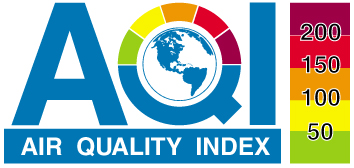Air Quality
You may have seen the Air Quality Index reported in your newspaper. The index was developed to help you determine ways to protect your family’s health when ozone levels reach the unhealthy range, and ways you can help reduce ozone air pollution.
Click this link to go to AirNow.gov
Air pollution can affect your health and the environment. There are actions every one of us can take to reduce air pollution and keep the air cleaner, and precautionary measures you can take to protect your health.
Like the weather, air quality changes from day to day. Up-to-date information allows you to make decisions based on air quality forecasts.
EnviroFlash is a notification system sponsored by the EPA with support from State and local air quality agencies. EnviroFlash provides air quality information such as forecasts and action day notifications via email for your area of interest. EnviroFlash gives you instant up-to-date air quality information that is especially helpful for those with sensitivities, such as the young, people with asthma, and the elderly.
The Ozone Action Partnership team is a group of individuals representing local government, industry, academia, and the medical community that works together as a region to voluntarily take steps to improve our air quality.
What is Ozone
Ozone (the molecular formula is O3) is a gas that occurs naturally both in the earths upper atmosphere and at ground level. Ozone can be good or bad, depending on where it is found.
Good ozone
Ozone occurs naturally in the earths upper atmosphere 10 to 30 miles above the earths surface where it shields us from the suns harmful ultraviolet rays.
Bad ozone
Higher levels of ozone are created by the combination of pollutants from many sources. Utility companies, industry, cars, gasoline-powered lawn equipment, paints, solvents, and even plants and treesall contribute to the formation of ozone. In the summer, higher levels of ozone form in the presence of heat and sunlight. Weather is a key factor in the formation of ozone.
When is ozone season?
Typically ozone forms on a cloudless day when temperatures are high and winds are stagnant. In our region, high ozone levels can be expected between the months of May and September.
What is our regions history?
For many years the ozone levels in Northeast Tennessee and Southwest Virginia have caused no concern. Last year, however, on two consecutive days in June one of the States air monitors in this area showed that we exceeded the national standard by a small degree. Also, EPA has set a new 8-hour ozone standard that is currently under review by the courts. The 8-hour standard is more stringent, and the state recorded 9 days in 2000 where this standard was exceeded in our area.
How does ground level ozone affect us?
Even at low levels ozone can cause a number of respiratory effects. Active children are at highest risk because they spend alot of time outdoors in the summer. They breathe faster and have less bodymass. Active adults who play hard and work hard outside are also at risk, aswell as the elderly and those people with asthma or other respiratory diseases.
Ozone exceedances can also impact the economic health of our region. Should we have another day where ozone levels are high, our region could be designated as non-attainment. This could jeopardize our ability to attract new business or grow the ones we have, we could lose federal highway dollars, and the State could impose certain actions such as a car inspection program. Although many metropolitan areas in the U.S. will be designated as non-attainment, this is not a label we want on our region.
What can we do?
Our region has formed an Ozone Action Partnership. Government, industry, academia, and the medical community have organized this volunteer effort in order to prevent high-ozone days. Working together and by voluntarily doing certain things, we can make a difference in our air quality. The Ozone Action Partnership has arranged for meteorologists from TVA to forecast ozone action days during the 2001 season. When the weather conditions are right, local media will call for an Ozone Action Day and ask people to:
- Delay mowing your yard or using gasoline-powered lawn equipment until after 6 p.m.
- Avoid grilling out or burning yard clippings or leaves.
- Drive your newest and most fuel-efficient car.
- Carpool to work, school, or lunch.
- Telecommute.
- Avoid areas where your vehicle will idle a long time like drive-thrus or congested intersections.
- Conserve energy.
- Put industry action plans into place to reduce nitrogen oxide emissions.
Why should we implement an ozone action program?
We can’t control the weather, but by working together voluntarily, we can keep our air clean and have a prosperous economy.
INTEGRATING CLIMATE CHANGE INTO THE TRANSPORTATION PLANNING PROCESS




